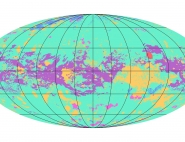Scientific Results obtained with VIMS instrument
Among the many results of this instrument, the following deserves mention:
A distant cousin of the African salt lakes discovered on Titan:
With the exception of Earth, Titan, Saturn's largest moon, is the only planetary body known to maintain liquids on its surface in a stable manner. On Titan, a complete hydrocarbon cycle, similar to the water cycle on Earth, is based on carbon, hydrogen and nitrogen atoms, and involves the atmosphere, the surface and below the surface. Titan's hydrocarbon lakes, discovered by the Cassini mission, are an integral part of this process.
A new study analysing the data from the Cassini probe indicates that the lake known by the name Ontario Lacus on Titan behaves in a similar way to those known as "salt lakes" on Earth.
Ontario Lacus is the largest lake on Titan's southern hemisphere. It is a large topographical depression, 230 km long and 75 km wide, and only a few metres deep. It is located in a large sedimentary basin, very flat and several hundred kilometres wide, surrounded by small mountains of only a few hundred metres high at the most.
Recently, a group from the University of Nantes (France) led by Thomas Cornet, an associate of the Cassini mission, found proof of the existence of channels enduring through the period 2007 to 2010, dug into the lake bed in its southern half. This leads them to suppose that Ontario Lacus, until now assumed to be completely full of liquid hydrocarbons (principally methane and ethane) might in reality be a topographic depression with a very flat bottom, which dries up and is refilled thanks to subterranean liquids, thereby forming liquid zones surrounded by wet materials (probably sand or mud).
"From this, we concluded that the solid bed of Ontario Lacus is in fact probably exposed in these regions," stated Thomas Cornet, whose article was recently published in the journal Icarus.
These characteristics make Ontario Lacus very similar to the ephemeral lakes known as "salt lakes" on Earth, among them the Etosha pan in a semiarid region of Namibia (Southern Africa).
![]()
Ontario Lacus (230 x 75 km, Titan) and the Etosha pan (120 x 65 km, Namibia), two ephemeral lakes separated by 1.4 billion kilometres. Credits: NASA/ESA/LPGNantes.
The Etosha pan is an example of a large ephemeral lake on Earth. Its dimensions are comparable to those of Ontario Lacus on Titan. During the rainy season, the water table, which normally lies a few tens of centimetres below the surface, is copiously fed with water and floods all or part of the Etosha pan. The liquids evaporate quickly due to the extreme aridity of the environment.
"On Earth, salt lakes tend to form in desert regions where liquids can suddenly accumulate. It therefore seems that the same thing happens on Titan," stated Bonnie Buratti, co-author and member of the Cassini team based at NASA's Jet Propulsion Laboratory in Pasadena, California.
Titan's climate is characterised by occasional storms giving rise to torrential precipitations, with evaporation rates higher than the average precipitation rate. This imbalance between evaporation and precipitation is the determining factor in the aridity of a climate, and it is therefore probable that Titan has an arid climate.
The strong similarities between Ontario Lacus and the Etosha pan, both from a morphological and climatic point of view, allow us to think that they may have been formed in a similar manner.
The Etosha pan developed due to the dissolution, over several million years, of a layer of limestone covering the sedimentary basin in which it lies. Ontario Lacus might therefore have arisen from the dissolution of a geological surface layer, formed of solid hydrocarbons produced in the atmosphere, accumulating on Titan's surface and soluble in liquid methane and ethane.
"These results underline the importance of comparative planetology in modern planetary science: finding familiar geological forms on extra-terrestrial worlds such as Titan allows us to test the theories for their formation," stated Nicolas Altobelli, project scientist on the Cassini mission at the European Space Agency (ESA).
The observations were made by the Cassini probe, and formed part of the Cassini-Huygens mission to the Saturnian system, a NASA, ESA and Italian Space Agency project.
Publication :
"Geomorphological Significance of Ontario Lacus on Titan: Integrated interpretation of Cassini VIMS, ISS and RADAR data and comparison with the Etosha Pan (Namibia)," by T. Cornet, O. Bourgeois, S. Le Mouélic, S. Rodriguez, C. Sotin, T. Lopez Gonzalez, G. Tobie, C. Fleurant, J.W. Barnes, R.H. Brown, K.H. Baines, B.J. Buratti, R.N. Clark and P.D. Nicholson, Icarus 218(2), 788-806, April 2012, doi:10.1016/j.icarus.2012.01.013


